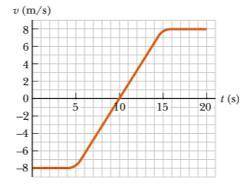
Physics, 02.09.2020 04:01 girlydiy17
The velocity vs. time graph for an object moving along a straight path is shown in Figure P2.24. (i) Find the average acceleration of the object during the time intervals (a) 0 to 5.0 s, (b) 5.0 s to 15 s, and (c) 0 to 20 s. (ii) Find the instantaneous acceleration at (a) 2.0 s, (b) 10 s, and (c) 18 s.


Answers: 2


Other questions on the subject: Physics

Physics, 22.06.2019 12:30, lmolder1329
Consider a 1000 w iron whose base plate is made of 0.5 cm thick aluminum alloy 2024-t6 (ρ = 2770 kg/m3 and cp = 875 j/kg°c). the base plate has a surface area of 0.03 m2. initially, the iron is in thermal equilibrium with the ambient air at 22°c. assuming 90% of the heat generated in the resistance wires is transferred to the plate, determine the minimum time needed for the plate temperature to reach 200°c.
Answers: 1



Physics, 23.06.2019 06:30, lovecats12
Acar weighs 15,000 n, and its tires are inflated to a pressure of 190kpa. how large is the area of the car's tires that are in contact with the road?
Answers: 1
You know the right answer?
The velocity vs. time graph for an object moving along a straight path is shown in Figure P2.24. (i)...
Questions in other subjects:




Mathematics, 12.04.2020 05:02

Mathematics, 12.04.2020 05:03

Mathematics, 12.04.2020 05:03


Social Studies, 12.04.2020 05:03


French, 12.04.2020 05:03



